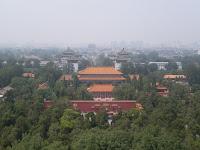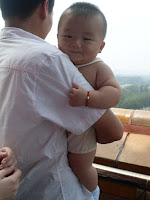 |
| My photograph of the Forbidden City in 2011. |
 |
| The Forbidden City in 1900. Source |
The Forbidden City or gugong (故宮)was crowned a UNESCO World Heritage site as it is considered the best preserved set of wooden structures in the world. It served as the imperial palace for emperors beginning in the Ming Dynasty until the end of the Qing Era, the last of China's dynasty periods. Construction began on the Forbidden City in 1406 under the charge of the Yongle Emperor Zhu Di, and it was completed in 1420. The city is about 180 acres and includes nearly 1,000 buildings.
As the Forbidden City is one of the most popular tourist attractions in Beijing—if not China—the area was completely crowded on the summer weekend my class visited. In addition, several local visitors wanted to take pictures of us. It was almost like we were a free attraction, especially for the family that had their hands in my braids at the entrance—strangely amusing!
Despite the occasional unwanted attention, I was happy to visit the Forbidden City as it is so well preserved. However, our class schedule was tight and we were only given two hours to explore, not nearly enough time to see everything. At least, I think a person would need half a day to thoroughly enjoy the Forbidden City.
 |
| A map of the Forbidden City. Source |
 |
| The Meridian Gate (wumen; 午門) |
Our class split into groups of our choosing and wandered around the complex. I now notice my group mainly saw the buildings in the center of the city; we were obviously being safe! I have a feeling we might have been afraid of getting lost and not making it to the end of the city in time. Nevertheless, we did get to see most of the more popular buildings. Unfortunately, when I visited in 2011, some of the buildings were closed to the public due to renovations (e.g., The Hall of Supreme Harmony). However, I am not sure which buildings are open or closed to the public as of now.
 |
| The Gate of Supreme Harmony (taihemen; 太和門) |
 |
| The Hall of Preserving Harmony (zhonghedian; 中和殿) |
 |
| I do not know what this building is called, but I thought the roofing was gorgeous. |
 |
| A resting area. |
The northwest corner tower(xibeijiaota; 西北角塔)
with interesting rock formation. |
A majestic old tree.
|
The moat around the Forbidden City.
|
 |
| A small alleyway. |
Funny side story:
A family from America came up to my group and expressed how happy they were to encounter another group of Americans. They were concerned that people kept touching their children's heads because they were blond. It's clear the people didn't want to harm their children, but if you have kids it might be something to think about when visiting crowded places in Beijing.
I think my favorite area of the Forbidden City was the Palace Museum which is housed in the complex. The museum is actually in more than one building, yet they are relatively close by. There are a variety interesting artifacts housed in the museum, yet the other half of the collection is kept at the National Palace Museum in Taiwan, which I visited in 2014.
 |
| The decorative ceiling in the main museum building. |
 |
| Golden spoons. |
 |
| A kind of massage device. |
Since the Forbidden City is extremely crowded during peak tourist season, I would have liked to simply look at it from Jingshan Park(景山公園)where we went after visiting the city. We spent less than an hour at the park which is actually quite large (57 acres) because we had an appointment for lunch. All of our time in Jinshan Park was spent on Jingshan Hill which offers a clear view of the Forbidden City. The hill is manmade, created during the Yongle Emperor's reign.
The Forbidden City seen from
Jingshan Park(景山公園).
|
The lake next to
Beihai Park(北海公園).
|
This baby was so cute!
I wanted to eat him up.
|
It was awesome to see the Forbidden City, but I would certainly go during the winter if I have a chance as there are less tourists during that time. Beijing occasionally experiences harsh winters, but I'd rather be cold and get to see everything comfortably than dripping in sweat in a sea of tourists! Jingshan Park is also a place I'd like to fully explore in the future.










No comments:
Post a Comment